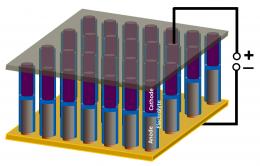Indian origin scientist designs nanosized batteries
Washington, July 31: 2011: A team led by an Indian origin scientist has packaged lithium ion batteries, which power mobiles and smartphones, into a single nanowire. The breakthrough could be a valuable power source for new generations of nanoelectronics.
Pulickel M. Ajayan, who did his B. Tech in metallurgical engineering from Banaras Hindu University in 1985, India and Ph.D. from Northwestern University US in 1989, had been inching towards single nanowire devices for years.
These researchers at Rice University first reported the creation of 3D nano batteries last December, the journal Nano Letters reported.
"The idea here is to fabricate nanowire energy storage devices with ultrathin separation between the electrodes," said Arava Leela Mohana Reddy, study co-author and research scientist, according to a university statement.
The team's experimental batteries are about 50 micrometres tall, as thick as a human hair and almost invisible when viewed edge-on, Reddy said.
Theoretically, the nanowire energy storage devices can be as long and as wide as the templates allow, which makes them scalable.
The nanowire devices show good capacity. The researchers are fine-tuning the materials to increase their ability to repeatedly charge and discharge, which now drops off after about 20 cycles.
A nanometre is a billion of a metre....IANS..NRIpress.com
-----------------------------------------------

New packaged lithium ion batteries will power mobiles and smartphones, into a single nanowire
The Rice lab Professor, Pulickel Ajayan has packed an entire lithium ion energy storage device into a single nanowire.
Nanoscale battery/supercapacitor devices in an array, as constructed at Rice University. The devices show promise for powering nanoscale electronics and as a research tool for understanding electrochemical phenomenon at the nanoscale. (Credit: Ajayan Lab/Rice University)
The research described testing two versions of their battery/supercapacitor hybrid.
- The first is a sandwich with nickel/tin anode, polyethylene oxide (PEO) electrolyte and polyaniline cathode layers; it was built as proof that lithium ions would move efficiently through the anode to the electrolyte and then to the supercapacitor-like cathode, which stores the ions in bulk and gives the device the ability to charge and discharge quickly.
- The second packs the same capabilities into a single nanowire. The researchers built centimeter-scale arrays containing thousands of nanowire devices, each about 150 nanometers wide. A nanometer is a billionth of a meter, thousands of times smaller than a human hair